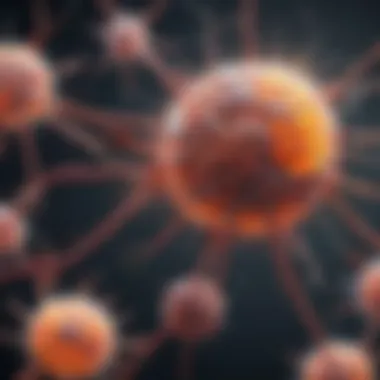Neuroinflammatory Diseases: The Link Between Inflammation and the Nervous System


Intro
Neuroinflammatory diseases involve intricate interactions between the immune system and the central nervous system (CNS). This relationship can lead to a spectrum of conditions that considerably affect individual health. Understanding how inflammation impacts the nervous system not only contributes to scientific knowledge but it also guides practical applications in medicine.
As research progresses, the landscape of neuroinflammatory diseases continues to evolve. With numerous studies examining underlying mechanisms and available treatments, this article will explore these phenomena in detail. The complexity of the nervous system and its immune interactions warrants a focused discussion on mechanisms of neuroinflammation, diagnostic methods, treatment options, and emerging trends in research.
The dialogue surrounding neuroinflammatory disorders is vital for students, researchers, and professionals working in neurology or closely related fields. As our understanding deepens, the possibilities for advancements in diagnostics and therapies expand. Ultimately, uncovering the factors associated with neuroinflammation promises to enhance knowledge around these debilitating diseases.
Recent Advances
Latest Discoveries
Recent research has revealed significant insights into the processes underlying neuroinflammation. Studies now highlight that certain immune responses can become activated inappropriately, leading to chronic conditions such as multiple sclerosis, Alzheimer’s disease, and Parkinson’s disease. Neuroscientists are increasingly focused on defining the role of microglia, the brain's resident immune cells, in managing inflammation. These cells can shift from a protective state to a harmful one if the balance in the CNS is disturbed.
Additionally, biomarkers for neuroinflammatory diseases are gaining attention. Recent findings indicate that specific proteins in cerebrospinal fluid can serve as indicators of inflammation. Identifying these proteins can offer quicker and more accurate diagnostic methods.
Technological Innovations
Advancements in imaging technologies such as magnetic resonance imaging (MRI) and positron emission tomography (PET) have enhanced our ability to visualize neuroinflammatory processes in real time. These methods allow for better detection of inflammation patterns in the CNS, facilitating earlier diagnosis and treatment. Emerging techniques in nanotechnology also show promise in delivering targeted therapies to specific brain areas, thus potentially reducing side effects.
Moreover, computational models are being developed to simulate neuroinflammatory responses. This approach can help researchers predict disease progression and response to treatment, offering valuable insights that can inform clinical strategies.
"Understanding the intersection of neuroinflammation and neurodegeneration is crucial for developing therapeutic interventions."
Methodology
Research Design
Research in the field of neuroinflammation often employs a combination of experimental and observational studies. Clinical trials play a crucial role in assessing new therapies, while laboratory studies focus on understanding cellular and molecular mechanisms. This mixed methodology helps in creating a comprehensive view of how inflammation manifests in the nervous system.
Data Collection Techniques
Data collection in neuroinflammatory disease research encompasses various methods. These may include clinical assessments, imaging studies, and biomarker evaluations. Patient registries and biobanks are also valuable resources for gathering long-term data that can help identify patterns in disease progression and response to treatments. Through these techniques, researchers aim to construct a detailed picture of how neuroinflammation affects different populations.
The continued exploration of these methodologies aids in uncovering the nuances of neuroinflammatory diseases, potentially leading to improvements in diagnoses and treatments.
Prolusion to Neuroinflammation
Neuroinflammation is a crucial area of study that explores the intersection of the immune system and the nervous system. Understanding this relationship is vital for comprehending many neurological diseases. Inflammatory processes in the brain can have profound effects on brain function and can lead to severe clinical manifestations. This section will shed light on why neuroinflammation matters and the implications it has for health and disease.
By detailing neuroinflammation's role in various conditions, we can appreciate the importance of targeting inflammation in treatment strategies. Furthermore, neuroinflammation is not just a symptom; it can be a driving force in the progression of diseases like Alzheimer’s, Parkinson's, and multiple sclerosis. This area of research is significant not only for developing new interventions but also for refining existing therapies targeting inflammation at its root.
Each component of neuroinflammation interacts in complex ways, meaning that its study requires an in-depth understanding of both cellular and molecular interactions. This section lays the groundwork for a comprehensive exploration of definitions, historical perspectives, and the evolution of thought around the concept of neuroinflammation.
Defining Neuroinflammation
Neuroinflammation refers to the inflammatory response within the brain or central nervous system (CNS). It is primarily mediated by glial cells, including microglia and astrocytes, which act as the first line of immune defense in the brain. When there is an injury, infection, or disease, these cells become activated, releasing various signaling molecules. This can lead to both protective and detrimental outcomes, depending on the context and duration of the inflammation.
Key markers of neuroinflammation include cytokines and chemokines, which facilitate communication between immune cells and recruit additional immune components to the site of inflammation. The role of neuroinflammation is significant; while it can help clear away pathogens, excessive or chronic neuroinflammation can contribute to neuronal damage and disease progression.
Historical Context
The understanding of neuroinflammation has evolved. Earlier beliefs dismissed the CNS as an immune-privileged site, assuming that inflammation was solely a peripheral issue. However, research from the late 20th century onward began to unveil the complexities of the brain's immune responses. For instance, findings demonstrated that microglia, once thought to be passive support cells, are active participants in inflammatory processes.
In recent decades, a surge of interest in neuroinflammation has arisen, prompted by increasing evidence linking inflammation to neurodegenerative diseases. This shift has driven scientific inquiry, revealing that inflammation may not only exacerbate existing conditions but may also initiate some neurodegenerative processes. Scholars now refer to neuroinflammation as a player in a range of neurological disorders, marking a pivotal change in how we approach CNS-related health issues.
Mechanisms of Neuroinflammation
The study of the mechanisms of neuroinflammation provides critical insights into how inflammation affects the brain and nervous system. Understanding this topic is vital for developing targeted therapies and improving patient outcomes. Neuroinflammation can lead to various neurodegenerative diseases, making these mechanisms a focal point in both research and clinical practice. The cellular components and molecular pathways involved in neuroinflammation play significant roles, determining the extent and impact of inflammatory responses.
Cellular Components
Microglia
Microglia are the primary immune cells in the central nervous system. They serve as the brain's first line of defense against pathogens and injury. One key characteristic of microglia is their ability to transform from a resting state to an active state when inflammation occurs. This activation is critical in the response to neuroinvasive challenges. Microglia release pro-inflammatory cytokines that can exacerbate or alleviate symptoms of neuroinflammatory diseases.
The unique feature of microglia is their capacity for phagocytosis. They can engulf and digest cellular debris, which is advantageous for maintaining brain homeostasis. However, an overactive response can lead to neurodegeneration, highlighting a potential disadvantage in chronic conditions.
Astrocytes
Astrocytes are star-shaped glial cells that provide structural support and metabolic assistance to neurons. They are particularly important during neuroinflammation due to their ability to secrete inflammatory mediators, thus influencing neuronal function. A key characteristic of astrocytes is their plasticity, allowing them to adapt to various states of injury and inflammation.
Astrocytes have unique features such as the release of glutamate, which can be both a beneficial signaling molecule and a potential neurotoxin in excess. This dual role complicates their contribution to neuroinflammatory diseases, demonstrating both protective and harmful pathways.
Neurons
Neurons, the functional units of the nervous system, are highly sensitive to inflammatory cytokines. Their vulnerability to neuroinflammation makes them crucial players in neuroinflammatory diseases. A key characteristic of neurons is their ability to transmit signals rapidly, but they have limited capacity for regeneration after injury.
One unique feature of neurons is their synaptic plasticity, which can be affected by inflammation. This can lead to altered communication between neurons, furthering disease progression. Understanding the impact of inflammation on neuronal function is crucial as it directly ties into the outcomes of neuroinflammatory diseases.


Molecular Pathways
Cytokines
Cytokines are signaling molecules that mediate and regulate immunity and inflammation. They play a key role in the neuroinflammatory cascade. A notable characteristic of cytokines is their ability to exert widespread effects on various cell types, including microglia and astrocytes. They are beneficial for the initial immune response, but excessive cytokine levels can contribute to chronic inflammation.
The unique feature of cytokines lies in their pleiotropic nature, meaning one cytokine can have multiple effects depending on the context. This adaptability presents both advantages in fighting infections and disadvantages in sustaining long-term inflammation.
Chemokines
Chemokines are a subset of cytokines with a primary function of directing cell migration. Their importance in neuroinflammation is profound as they guide immune cells to sites of inflammation in the nervous system. A key characteristic of chemokines is their specificity in attracting particular cell types, which is essential for a coordinated immune response.
A unique feature of chemokines is their role in establishing gradients that guide leukocyte recruitment. The disadvantage lies in their potential for excessive chemotaxis, leading to an overaccumulation of immune cells that can worsen inflammation.
Prostaglandins
Prostaglandins are lipid compounds that have significant roles in mediating inflammation. They are produced at sites of inflammation and contribute to various processes, including pain and immune responses. Their key characteristic is their short half-life, allowing them to act rapidly but also making their regulation complex.
A unique aspect of prostaglandins is their dual role in inflammation. They can promote healing by initiating repair processes, but can also perpetuate pain and discomfort. This dichotomy is crucial in understanding their overall impact on neuroinflammatory diseases.
Common Neuroinflammatory Diseases
Neuroinflammatory diseases are a critical area of study because they illustrate the profound consequences of inflammation within the central nervous system. Understanding these diseases helps in grasping how inflammation contributes to neurodegeneration and other neurological impairments. The focus on common neuroinflammatory diseases reveals the way they manifest in diverse symptoms and progression, which can significantly affect a person's quality of life.
Recognizing the impact of conditions like Multiple Sclerosis, Alzheimer's Disease, Parkinson's Disease, and Amyotrophic Lateral Sclerosis offers insight into their pathophysiological mechanisms. Each of these diseases showcases different aspects of neuroinflammation, contributing to our broader understanding of how immune responses can lead to negative outcomes in the nervous system.
Multiple Sclerosis
Multiple Sclerosis is characterized by the degradation of the myelin sheath that protects neurons, leading to nerve signal disruption. The immune system wrongly attacks healthy tissues, particularly the myelin. This disease can lead to a range of symptoms including fatigue, difficulty walking, and problems with coordination.
Diagnosis is through clinical evaluations and imaging techniques such as MRI. Effective treatments include immunomodulators which can modify the course of the disease. Awareness of multiple sclerosis enhances understanding of how immune activation contributes to neuroinflammation and impacts patient lives.
Alzheimer's Disease
Alzheimer's Disease is a progressive neurodegenerative disorder. It primarily affects memory and cognitive function. Neuroinflammation plays a significant role in its pathogenesis, characterized by the accumulation of amyloid plaques and tau tangles in the brain. These proteins disrupt neuron communication and trigger inflammatory responses that worsen neuronal damage.
Detecting this disease early is vital to managing its symptoms. Standard diagnostic methods include neuroimaging and cognitive assessments. Current therapeutics focus on symptomatic relief but ongoing research explores disease-modifying strategies that might alter the course.
Parkinson's Disease
Parkinson's Disease is marked by the loss of dopamine-producing neurons. The neuroinflammatory processes involved can accelerate neuronal death. Symptoms include tremors, stiffness, and balance problems, all leading to significant functional impairment.
Diagnosis relies heavily on clinical criteria and excluding other conditions. There is no cure, but symptomatic treatments such as levodopa can improve quality of life. Understanding inflammation's role in Parkinson's helps researchers develop new therapeutics aimed at slowing disease progression.
Amyotrophic Lateral Sclerosis
Amyotrophic Lateral Sclerosis (ALS) involves the degeneration of motor neurons, severely affecting muscle control. Neuroinflammation is suspected to influence the progression of ALS, leading to increased neuronal death. Symptoms may include muscle weakness, speech difficulties, and respiratory issues, making it a particularly debilitating condition.
Diagnosing ALS typically involves various tests to rule out other diseases. While there is no cure, existing therapies, like Riluzole, may modestly extend survival. Examining neuroinflammation in ALS offers avenues for future research focused on neuroprotective agents that might halt or slow down its progression.
Understanding these common neuroinflammatory diseases allows for better diagnostic protocols and treatment strategies, ultimately improving patient outcomes.
Pathophysiology of Neuroinflammatory Diseases
Understanding the pathophysiology of neuroinflammatory diseases is essential for several reasons. First, it unveils the intricate processes that lead to neuronal damage and dysfunction. This section provides a framework for analyzing how inflammatory responses can transition from protective to pathological. Additionally, it emphasizes the significance of understanding these mechanisms for developing effective therapeutic strategies. The relationship between inflammation and neurodegeneration offers insights not only into disease progression but also into potential interventions.
Immune Activation
Immune activation is a critical aspect in the pathophysiology of neuroinflammatory diseases. Under normal circumstances, the central nervous system (CNS) has a unique immune environment that preserves optimal functioning. However, factors like infections, trauma, or genetic predispositions can trigger this immune response, leading to activation of various immune cells.
Microglia, which are resident immune cells in the CNS, play a crucial role in initiating the inflammatory response. Once activated, they release a range of pro-inflammatory cytokines, including interleukin-1 beta (IL-1β) and tumor necrosis factor-alpha (TNF-α). These substances, while initially protective, can become detrimental in excess. Chronic activation can result in a toxic environment that contributes to neuronal damage and loss. This creates a feedback loop where neuroinflammation perpetuates neuronal degeneration, leading to exacerbated symptoms in diseases such as Multiple Sclerosis and Alzheimer's.
Key points about immune activation include:
- Neuroinflammation can serve beneficial roles but can also be the catalyst for disease.
- Persistent stimulation of the immune response leads to chronic inflammation.
- Identifying the triggers of immune activation can help in developing preventive measures.
"The immune response in the CNS must be finely tuned; an imbalance can result in more harm than good."
Neurodegeneration
Neurodegeneration refers to the progressive loss of structure and function of neurons. It is a common consequence of prolonged neuroinflammation. In the context of neuroinflammatory diseases, neurodegeneration is characterized by the breakdown of neuronal integration and connectivity. Neuroinflammatory mediators can lead to apoptosis, or programmed cell death, contributing to the decline of cognitive and motor functions.
The processes involved in neurodegeneration are multifaceted. Cytokines and chemokines from immune cells can influence neuronal survival pathways. For instance, excessive levels of beta-amyloid are known to induce neurotoxic effects and are significant in Alzheimer's disease. Similarly, in Multiple Sclerosis, the demyelination of neurons disrupts communication within the nervous system, leading to severe physical and cognitive impairments.
Understanding neurodegeneration entails:
- Investigating how inflammation impacts neuronal integrity.
- Recognizing biomarkers that signify neurodegenerative processes.
- Developing approaches to counteract or reverse the damaging effects of chronic inflammation.
Diagnosing Neuroinflammatory Diseases
Diagnosing neuroinflammatory diseases is critical for effective treatment planning and patient care. The symptoms of these diseases can be diverse and often overlap with other conditions, making accurate diagnosis challenging. Early and precise identification not only optimizes patient outcomes but also helps in understanding the progression of the disease.


This section will explore the key elements involved in diagnosing neuroinflammatory diseases, focusing on clinical evaluation, imaging techniques, and biomarkers.
Clinical Evaluation
Clinical evaluation is the first step in diagnosing neuroinflammatory diseases. Physicians conduct a detailed assessment of the patient’s medical history, symptoms, and recent health changes. Key symptoms may include cognitive decline, muscle weakness, and changes in sensory perception.
A thorough neurologic examination helps identify specific neurological deficits. The evaluation may also include cognitive tests to assess memory, attention, and executive functions, especially in diseases like Alzheimer's. Notably, a comprehensive history is essential to distinguish between different neuroinflammatory diseases and other disorders.
Imaging Techniques
MRI
Magnetic Resonance Imaging (MRI) is a cornerstone in diagnosing neuroinflammatory diseases. This imaging technique provides detailed images of the brain and spinal cord, helping to reveal lesions or abnormalities.
The key characteristic of MRI is its ability to produce high-resolution images without exposure to ionizing radiation, making it a safe option for repeated use. One unique feature of MRI is its capability to visualize brain structures and assess the presence of demyelination, which is critical in conditions like Multiple Sclerosis.
However, while MRI is highly beneficial, it comes with limitations. It may not always detect early changes or subtle lesions, and interpretation can be subjective, sometimes leading to misdiagnosis.
PET Scan
Positron Emission Tomography (PET) scans offer a functional view of brain activity, which is invaluable in diagnosing neuroinflammatory diseases. PET scans can measure metabolic changes and reveal areas of inflammation or neurodegeneration that may not be visible on MRI.
A key characteristic of PET scans is their ability to use radioactive tracers, which highlight cellular activity and help pinpoint areas of concern. This aspect makes PET particularly useful in assessing conditions like Alzheimer's, where metabolic decline may precede structural changes.
However, PET scans also come with disadvantages. The need for radioactive tracers raises concerns about exposure to radiation. Additionally, PET is generally less accessible than MRI and may be cost-prohibitive for some patients.
Biomarkers
Biomarkers are becoming an increasingly important tool in diagnosing neuroinflammatory diseases. They can include proteins, genes, and specific metabolites detectable through blood tests or cerebrospinal fluid analysis. For example, elevated levels of certain cytokines may indicate ongoing inflammation in the nervous system.
The use of biomarkers can facilitate early diagnosis, guide treatment decisions, and monitor disease progression. However, their effectiveness often depends on further research to validate their reliability and specificity in diagnosing various neuroinflammatory diseases.
In summary, diagnosing neuroinflammatory diseases involves a multi-faceted approach combining clinical evaluation, advanced imaging techniques, and biomarker analysis. Each element plays a pivotal role in ensuring accurate diagnosis and effective management of these complex disorders.
Treatment Approaches for Neuroinflammatory Diseases
The treatment approaches for neuroinflammatory diseases are a central focus of this discussion. Understanding various options is vital for managing these complex disorders. Treatments can be broadly categorized into pharmacological and non-pharmacological interventions. Each section entails specific strategies aimed at ameliorating symptoms and improving patients’ quality of life. It is essential to consider effectiveness, safety, and individualized responses when selecting treatment options for patients.
Pharmacological Treatments
Immunomodulators
Immunomodulators represent a key element in the pharmacological treatment of neuroinflammatory diseases. These drugs work by modifying the immune response, aiming to restore balance and minimize harmful inflammation. The notable characteristic of immunomodulators is their ability to target specific pathways involved in immune activation, which helps to prevent further damage to the nervous system.
One of the main benefits of immunomodulators in this context is their effectiveness in conditions such as Multiple Sclerosis, where they help reduce the frequency of relapses. However, it is important to note that immunomodulators can lead to side effects. Their usage might increase vulnerability to infections due to their impact on the immune system.
Anti-inflammatory Drugs
Anti-inflammatory drugs play another significant role in managing neuroinflammatory diseases. They directly target inflammation and are often used to alleviate pain associated with such conditions. A key characteristic of these drugs is their ability to reduce the production of inflammatory mediators. This reduction helps to manage symptoms associated with various neuroinflammatory disorders.
These drugs are commonly favored due to their widespread availability and proven efficacy. However, long-term use can raise concerns over potential side effects, including gastrointestinal issues or cardiovascular risks. Therefore, careful monitoring is essential when engaging these treatment modalities.
Non-Pharmacological Interventions
Physical Therapy
Physical therapy is an essential non-pharmacological intervention for individuals suffering from neuroinflammatory diseases. It focuses on improving motor function and mobility, addressing the physical limitations that often arise from such conditions. The central characteristic of physical therapy is its tailored approach to each patient’s unique needs, considering their specific deficits and goals.
This intervention can be particularly beneficial in enhancing overall physical fitness and promoting independence. Incorporating physical therapy often leads to improved muscle strength and coordination. However, patients must commit to consistent sessions, and the response may vary based on individuals’ baseline conditions.
Nutritional Approaches
Nutritional approaches can significantly impact patients dealing with neuroinflammatory diseases. These strategies focus on optimizing dietary habits to help combat inflammation in the body. A key feature of nutritional interventions is their potential to enhance overall health and well-being, which can be particularly beneficial for patients facing various challenges.
A balanced diet rich in antioxidants, omega-3 fatty acids, and other nutrients can help modulate inflammatory responses. This support can potentially translate to better outcomes in managing symptoms. However, the diversity of dietary preferences and restrictions can pose challenges in tailoring effective nutritional strategies for individuals.
In summary, both pharmacological and non-pharmacological treatments are crucial in managing neuroinflammatory diseases. Each approach has unique features, advantages, and limitations.
The integration of these treatment modalities can lead to comprehensive care tailored to individual patient needs. As research evolves, new insights will likely continue to refine and improve treatment strategies in this dynamic field.
Research Trends in Neuroinflammation
Neuroinflammation is an expanding field of study that offers valuable insights into the complexities of the nervous system and its interactions with the immune system. As researchers continue to uncover the cellular and molecular mechanisms underlying neuroinflammatory diseases, it becomes imperative to consider the latest trends in this area of investigation. Understanding these trends provides a roadmap for future research and clinical application.
- Importance of Staying Current: Engaging with current research trends allows professionals in the field to stay informed about promising therapeutic strategies and emerging biomarker discoveries. It helps in developing interventions that can provide improved patient outcomes.
- Collaboration Across Disciplines: Recent trends underscore the need for interdisciplinary collaboration. Neuroscience, immunology, genetics, and microbiology are converging. Each discipline contributes unique insights into neuroinflammatory mechanisms, enhancing the overall understanding of disorders such as multiple sclerosis and Alzheimer’s disease.
"Research trends in neuroinflammation are crucial for unraveling the complexities of neurodegeneration and immune responses in the central nervous system."
- Focus on Personalized Medicine: A significant trend is the movement towards personalized treatment. By recognizing that genetic and environmental factors impact disease onset and progression, researchers aim to tailor therapies that suit individual patient profiles, thus increasing treatment efficacy while minimizing side effects.


Emerging Therapeutics
Emerging therapeutics are transforming the landscape of neuroinflammatory disease treatment. Recently, scientists are exploring novel compounds and mechanisms that target specific pathways involved in neuroinflammation. Here are a few key areas of interest:
- Monoclonal Antibodies: Biopharmaceuticals, especially monoclonal antibodies, are gaining traction. They specifically target inflammatory processes in diseases such as multiple sclerosis.
- Gene Editing Technologies: Advancements in CRISPR and other gene-editing technologies are piquing interest. Researchers are investigating their potential to correct genetic predispositions related to neuroinflammatory diseases.
- Neuroprotective Agents: There is a growing emphasis on discovering neuroprotective agents that can shield neuronal cells from inflammatory damage. Such agents might mitigate disease progression and enhance neuronal health.
Genetic and Environmental Factors
Genetic and environmental factors play a crucial role in the development and progression of neuroinflammatory diseases. Understanding this interplay is essential for developing effective prevention and treatment strategies. Researchers are delving into:
- Genetic Predispositions: Certain genes have been associated with a higher risk of developing conditions like Alzheimer’s and Parkinson’s diseases.
- Environmental Triggers: Factors such as toxins, dietary influences, and infections also contribute to inflammation in the nervous system. Studies continue to examine how these elements interact with genetic factors to initiate or exacerbate disease.
The Role of the Gut Microbiome
The gut microbiome is the community of microbes residing in the digestive tract, and it has emerged as a significant area of interest in the study of neuroinflammation. Recent evidence suggests that:
- Microbiome-Brain Axis: There is a complex communication between the gut microbiome and the central nervous system, often referred to as the microbiome-brain axis. This connection may influence inflammation and even mood disorders.
- Therapeutic Potentials: Modifying gut microbiota through probiotics or dietary changes has shown potential in alleviating neuroinflammatory symptoms. Researchers are exploring how these modifications might enhance treatment responses in neurodegenerative diseases.
Preventive Strategies
Preventive strategies in the context of neuroinflammatory diseases are essential for mitigating the risk and severity of these conditions. They encompass various lifestyle choices and dietary considerations aimed at reducing inflammation in the nervous system. By adopting specific preventive measures, individuals can enhance their overall well-being and potentially decrease the likelihood of developing neuroinflammatory disorders.
Lifestyle Modifications
Making effective lifestyle modifications can significantly influence neuroinflammatory processes. Key elements of these modifications include:
- Regular Exercise: Engaging in physical activity is known to reduce inflammation. Exercise promotes the release of anti-inflammatory cytokines and supports overall brain health.
- Stress Management: Chronic stress can exacerbate inflammation. Implementing techniques such as mindfulness, yoga, or deep-breathing exercises can be beneficial. Reducing stress levels may also enhance immune function.
- Sleep Hygiene: Quality sleep is crucial for brain function and immune regulation. Developing a consistent sleep schedule and creating a restful environment contributes to restorative sleep, which can help control inflammation in the body.
- Avoiding Smoking and Excessive Alcohol: Both smoking and high alcohol consumption have been linked to increased inflammation. Quitting smoking and moderating alcohol intake can significantly lower inflammatory markers.
Dietary Considerations
Diet plays a crucial role in supporting anti-inflammatory mechanisms within the body. Certain dietary choices can help in preventing neuroinflammation and promoting brain health. Here are some important dietary considerations:
- Anti-Inflammatory Foods: Incorporating foods rich in omega-3 fatty acids, such as salmon, walnuts, and flaxseeds can mitigate inflammation. Fruits and vegetables, particularly berries, leafy greens, and cruciferous vegetables, are also beneficial due to their high antioxidant content.
- Whole Foods Approach: Focusing on whole grains, nuts, seeds, and legumes instead of processed foods contributes to a healthier diet. Avoiding additives and preservatives found in processed products can positively impact inflammation levels.
- Hydration: Staying hydrated is important for maintaining physiological processes in the body. Adequate water intake supports cellular function and can dilute inflammatory markers in the bloodstream.
- Limit Sugar and Saturated Fats: High intake of sugar and saturated fats can promote inflammation. Reducing consumption of sugary snacks, beverages, and processed meat can help lower the risk of neuroinflammatory diseases.
"Dietary choices not only affect overall health but can also play a significant role in the body's inflammatory response."
In summary, preventing neuroinflammatory diseases involves a proactive approach through lifestyle modifications and dietary choices. By prioritizing healthful practices, individuals can foster a more robust immune system and protect their nervous system from the damaging effects of inflammation.
Future Directions in Neuroinflammatory Research
Understanding the future directions in neuroinflammation research is crucial for developing new strategies to combat neuroinflammatory diseases. As researchers delve deeper, insights emerge about potential therapies and the underlying mechanics of neuroinflammation. The focus on innovative treatments and understanding contributing factors enhances our knowledge of how inflammation influences the nervous system. This section discusses potential future avenues of research, especially gene therapy and the challenges researchers face in translating findings into real-world applications.
Potential for Gene Therapy
Gene therapy represents a promising frontier in neuroinflammatory research. This approach aims to address genetic mutations that contribute to neuroinflammatory diseases by introducing or altering genes responsible for specific conditions. The ability to target genetic anomalies offers a precise method to mitigate the immune response that triggers these diseases. Furthermore, ongoing studies are revealing potential applications of gene therapy to regulate neuroinflammatory pathways. This can lead to increased resilience in neuronal cells or a reduction in inflammatory mediators.
One advantage of gene therapy is its adaptability. Each neuroinflammatory disease may have unique genetic factors at play. Therefore, tailored therapy could emerge that addresses individual patient profiles based on genetic information. However, this approach necessitates rigorous testing to ensure both efficacy and safety.
In clinical trials, the potential for gene therapy is significant but still in early stages. Research institutions and biotech companies are collaborating to explore delivery mechanisms, such as viral vectors or CRISPR technology. These methods need to overcome barriers to efficiently target the CNS, a critical consideration for future advancements.
Challenges in Research and Clinical Application
While the potential of gene therapy is evident, several challenges impede its clinical application. First, there is the complexity of the central nervous system itself. The blood-brain barrier presents a significant obstacle in delivering therapeutic agents effectively. Strategies to bypass or modify this barrier are critical for the success of gene therapy.
Second, the ethical implications of genetic manipulation in humans cannot be overlooked. Regulatory frameworks must evolve alongside scientific advancements to ensure compliance and oversight. Patient safety, long-term effects, and public acceptance are pivotal considerations for researchers and practitioners alike.
Lastly, funding for innovative research remains a challenge. Many studies require substantial financial investment, which may limit the pace of discovery. Collaboration among academic institutions, industry leaders, and government agencies could provide the necessary resources to explore gene therapy further.
"The future of neuroinflammatory disease treatment lies in our ability to embrace innovation while navigating the complexities of science and ethics."
End
The conclusion serves as a pivotal component in understanding neuroinflammatory diseases. It encapsulates the insights drawn from the article, highlighting the intertwining complexities of the immune system and the central nervous system. This synthesis of findings is not merely a summary; it is a reflection on the conclusive elements that illustrate the significance of inflammation in various neurological conditions.
A primary consideration is the relationship between neuroinflammation and its disease outcomes. Multiple sclerosis, Alzheimer’s disease, and Parkinson’s disease illustrate various pathways through which inflammation instigates neurodegeneration. By grasping this relationship, students, researchers, and healthcare professionals can appreciate the implications of neuroinflammatory processes in clinical settings. Furthermore, the dialogue around diagnostic techniques such as MRI and the role of biomarkers proves crucial. These methods advance the pursuit of accurate identification of diseases, fostering timely and effective interventions.
Synthesis of Findings
The evidence presented throughout the article converges on the realization that neuroinflammatory diseases are the product of intricate biological mechanisms. From immune activation to neurodegeneration, each aspect underscores the need for a nuanced understanding of how inflammation influences neural health.
"Neuroinflammation is both a protective and a pathological response, demonstrating the dual nature of the immune system's role in neurological health."
Several key findings include:
- The role of microglia and astrocytes as major players in neuroinflammatory responses.
- The significance of inflammatory mediators such as cytokines in shaping disease pathology.
- The importance of innovative research directions, including the potential impacts of gene therapy and the gut microbiome on neuroinflammation.
Such insights not only expand our current knowledge but also provide a foundation for future explorations in this field.
Implications for Future Research
Future research avenues in neuroinflammation hold considerable promise. The potential for gene therapy as a treatment option is particularly noteworthy. Advances in understanding genetic predispositions to neuroinflammatory diseases can revolutionize how we approach prevention and intervention.
Other critical research implications include:
- The exploration of non-pharmacological methods such as nutrition and lifestyle adjustments.
- Investigating the gut-brain axis and its role in mediating inflammatory responses.
- Assessing environmental factors that may contribute to the exacerbation or mitigation of neuroinflammatory diseases.
A comprehensive examination of these areas can lead to more effective therapeutic strategies, improving patient outcomes and enhancing overall health in individuals affected by neuroinflammatory conditions. The future of neuroinflammatory research is not only about addressing immediate health concerns but also about fostering long-term understanding in a rapidly evolving field.















